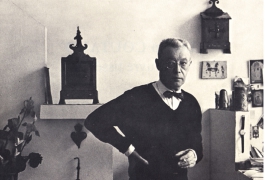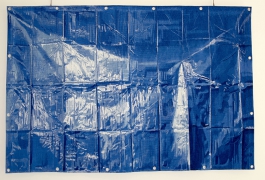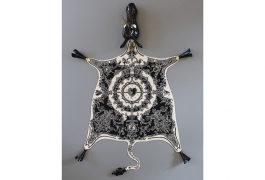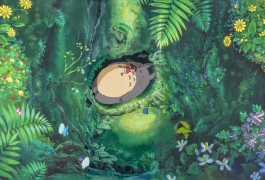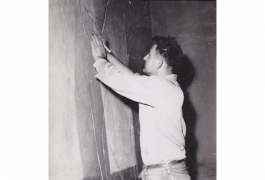Clément Cogitore
The artist and director Clément Cogitore played along the adaptation of a work into an Aubusson tapestry, thanks to the patronage of the corporate foundation AG2R La Mondiale for artistic vitality.
Within the scope of the regional Funding for contemporary tapestries creation, and in parallel with calls for projects launched every year since 2010, the Cité internationale works for the Aubusson tapestries creation and thus, supporting its economical field through specific projects, realized in partnership with artists, architects, galleries, studios or other institutions.
The Cité internationale works currently with the artist and director Clément Cogitore in the aim to create a tapestry, unavoidably contemporary, adapted from a picture created from several screenshots of the 2011 actuality, during the Egyptian revolutions: Ghost_Horseman_of_the_Apocalypse_in_Cairo_Egypt.jpg. This collaboration is the result of the meeting, a few years ago, of the headmaster of the Cité internationale Emmanuel Gérard and Clément Cogitore, by the intermediary of Jérémy Planchon and Camille de Bayser.
The acquisition of this sketch, which integrates the “Musée de France” collections of the Cité internationale, is supported by the corporate foundation AG2R La Mondiale for its artistic vitality. Created in April 2007, this corporate foundation dedicated to the cultural patronage is engaged in favor of the territories, the preservation of the regional cultural heritage, material and immaterial, the valorization of the contemporary creation, so as the promotion of the artistic professions.
Ghost_Horseman_of_the_Apocalypse_in_Cairo_Egypt.jpg
Clément Cogitore is interested in the tradition of the battle representation in the artistic field, for its cinegenic aspects and its quality in producing stories, fiction and novels, by relying on Paolo Uccello’s iconography, with his Battle of San Romano (around 1456).
For his tapestry project, Clément Cogitore draws his inspiration from the actuality pictures of the 2011 riots on Tahrir’s place in Egypt. Among the riots’ plans, a sequence was particularly reused worldwide because a luminous halo (a flare[1]) crossed through the crowd and evoking the silhouette of a man on a horse. Netizens all over the world then identified it with the one of the fourth rider of the Apocalypse, making of those images a new story.
Working from very enlarged screenshots, Clément Cogitore have an interest in the relationship between the digital picture and the tapestry and their common relationship with the pixel. The discovery of the know-how is then considered as a preparation time essential to the model creation.
“This project falls in with my work about very little defined images, circulating in a network sparking off stories, beliefs or superstitionby the viewer in his absence of details. By the lack of informations it communicates, the image becomes then a projection media of the spectator’s imagination, opened to every possibilities”, Clément Cogitore
The technical adaptation
What is technically at stake is the interpretation with the cartoon painter and the weaver of a very little defined digital picture, so compressed that the details are missing, and its translation into a rather wide weaving, giving a strong presence to the textile, in important dimensions: 5X2 meters. To determine the choice of color and material and define the “grain” of the future tapestry (the weaving’s size), the artist, accompanied by a technical comity constituted by the Cité internationale, chose to have “tirelles” realized, that is small samples, weaved only on a few centimeters wide. The weaving comity works to define a precise bill of specifications for the weaving of the work, for the launch of adjudications by the weaving workshops of the Aubusson-Felletin region. The tapestry will join the contemporary Content of the Cité internationale.

Born in 1983 in Colmar, Clément Cogitore lives and works in Paris. He is represented by the Eva Hober Gallery (Paris) and the Reinhard Hauff Gallery (Stuttgart).
After studying at the Superior School for Decorative Arts in Strasbourg and at Fresnoy-National Studio of Contemporary Arts, Clément Cogitore develops an experience in-between the cinema and the contemporary arts. Merging films, video, installations and photographs, his work questions the condition of cohabitation between humans and their images. It is most of the time question of rituals, collective remembrance, representation of the sacred so as a certain idea of the permeability of the worlds.
Clément Cogitore was awarded in 2011 the Great price of the Montrouge Salon, then nominated for the year 2012 as pensionary of the Académie de France in Rome-Villa Médicis. In 2015, his first feature film Ni le ciel, Ni la terre was awarded by the Prix de la Fondation Gan at the Cannes Festival – Critique’s week. It was nominated for the 2016 Césars in the First Film category. It received in 2016 the Prix Sciences Po for contemporary art, so as the Prix de la Fondation Ricard: two of its works were then selected to integrate the Centre Pompidou’s collection, national Museum of modern art, and are currently on display. His work was exposed during the summer of 2016 at the Palais de Tokyo. First laureate of the Prix le BAL for Young Creation with the ADAGP, he presents his project Braguino ou La communauté impossible at the BAL (“independent platform of exhibition, edition, reflexion and education, dedicated to the contemporary image under all of its forms”) until the 24th, December 2017. A project which received a special distinction from the Grand Prix de la competition internationale du FIDMarseille last July. Clément Cogitore is competing for the Prix Marcel Duchamp 2018 beside the artists Mohammed Bourouissa, Thu Van Tran and Marie Voignier.
[1] A flare is an optical aberration due to an interfering light spread in the camera lens.



